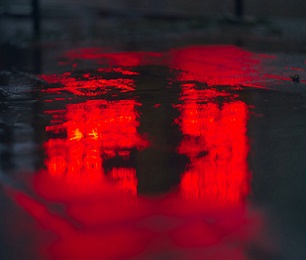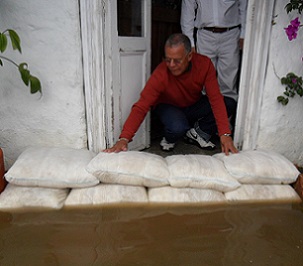 Photo by Ed Leszczynskl on free photo website Unsplash.
Photo by Ed Leszczynskl on free photo website Unsplash.
 Red umbrella. Photo by Aline Nadai on free photo website Pexels.
Red umbrella. Photo by Aline Nadai on free photo website Pexels.
 FloodSax alternative sandbags keeping filthy floodwater out of a house
FloodSax alternative sandbags keeping filthy floodwater out of a house
What is blood rain and does it ever hit the UK?
‘Blood’ may fall from the UK skies this week in a bizarre weather phenomenon.
Yes, it all sounds very dramatic but so-called blood rain is actually dust particles which have usually blown up from the Sahara and then come down in heavy rain, giving it the appearance of being yellow, brown or, in extreme circumstances, even red.
With soaring temperatures in the south of England at the moment and the risk of thunderstorms, any heavy rain will bring the ‘blood’ dust down on us.
A similar dust cloud originating from the Sahara was last seen in the UK in March, causing the skies to turn temporarily orange.
According to the Met Office: “It’s understood that blood rain occurs when relatively high concentrations of red coloured dust or particles get mixed into rain, giving it a red appearance as it falls.
“Blood rain is not actually a meteorological or scientific term - instead it’s a colloquial phrase which can be found going a fair way back in history.”
The first mention of blood rain stretches well back into history to Homer's Iliad, the epic poem which describes the siege of Troy and is thought to have been written around the 8th Century BC. Blood rain was, unsurprisingly, seen as a bad omen.
The Met Office has a detailed explanation about how blood rain happens.
It states: “The forces that drive our weather can be quite powerful and do some surprising things - including lifting things like sand or even small objects and transporting them large distances.
“In the case of blood rain, strong winds or storms can whip up dust and sand. As this becomes airborne it can get caught up in atmospheric circulation where it can be carried for thousands of miles.
“Eventually the dust will either fall out of the sky due to gravity or will be caught up in rain clouds where it mixes with the water droplets. When these fall as rain the raindrops could appear red.”
Blood rain happens quite often in the UK but is more browny than bloody and will leave dust all over your car.
The Met Office adds: “Each year on several occasions the UK will see rain falling with some amount of dust mixed into it. This usually comes from the Sahara before mixing in clouds and falling out.
“However, the dust we see is usually yellow or brown and mixed in very low concentrations - so the rain would look just the same as usual. The only difference would be that you might find a thin film of dust on your car or windows after the water has evaporated.
“So we rarely if ever see ‘proper’ blood rain here in the UK.”
But rain is rain if it’s blood rain or not and with the onset of climate change the UK is experiencing wetter and stormier weather than it did in the past.
Don’t forget that local councils have no responsibility to provide sandbags so it’s worth taking a look at FloodSax (http://www.floodsax.co.uk/) alternative sandbags to protect your home or business.
They are incredibly space-saving to store and quick and easy to deploy.